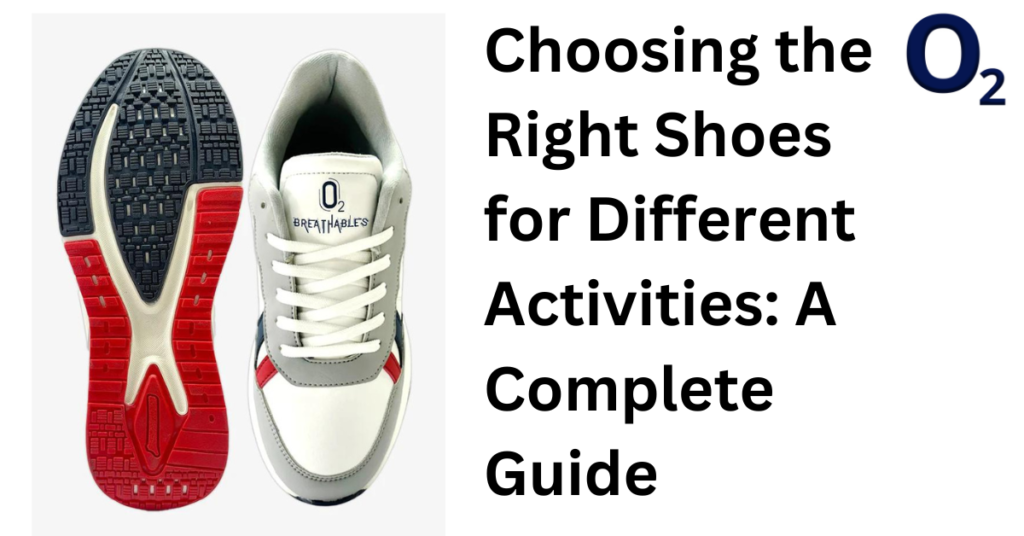Selecting the right pair of sneakers for various activities is crucial when it comes to footwear. The shoes you wear can affect how comfortable you feel, how well you perform, and even how safe you are. The correct sneakers can significantly improve your experience, whether you’re playing a sport, going for a walk, running, hiking, or enjoying the outdoors.
Imagine wearing sneakers with insufficient support or that pinch your toes while taking a lengthy stroll. Your feet may ache after the walk, and you may have fatigue or even blisters. Whereas, wearing the appropriate walking sneakers might make you feel more at ease and energized. This will enhance the entire experience.
So, in this guide first understand how to choose the best sneakers for different activities. We will also help you explore some tips that can help you find the right regular-use shoes that keep you comfortable and help you avoid injuries.
Walking Shoes
Walking sneakers are supportive and comfortable for regular walks. Here is what you should look for:
- Cushioning: A good walking sneakers should have lots of cushioning to absorb impact. Make sure the tongue and collar are padded and made of soft materials.
- Support: Always check that the shoe offers sufficient arch support. This lessens the chance of foot tiredness, particularly on prolonged treks.
- Lightweight: Select sneaker that won’t make you feel heavy. Walking is more pleasant and easier with a lighter shoe.
- Flexible Sole: Natural foot mobility is made possible by shoes with flexible soles. To see if the shoe flexes readily, try bending it.
Running Shoes
Running shoes are specifically designed for the high-impact nature of running. Here is what you must consider:
- Cushioning: Look for sneakers with superior cushioning to lessen the impact on your joints and absorb shock.
- Stability: Depending on your foot type, you may need stability sneakers. These provide support to help control overpronation.
- Breathability: Running produces a lot of heat. Therefore to keep your feet cool and comfortable, use sneakers made of breathable materials.
- Fit: To avoid discomfort during running, make sure the sneakers fits you easily.
Hiking Shoes
As hiking shoes are made for rough terrain, they must be supportive and strong. What to look for is as follows:
- Traction: If you want to hike on rocky or slick paths, look for sneakers with a sturdy outsole that offers good grip on a variety of surfaces.
- Support: Select footwear that provides ankle support, especially if you plan to carry a bulky backpack. You can also style it with high tops that may offer more stability.
- Water Resistance: To keep your feet dry when hiking in wet situations, think about wearing waterproof shoes or boots.
- Durability: Choose sneakers made of materials that are resilient to harsh environments because hiking can be hard on them.
Casual Shoes
Casual shoes are meant for everyday wear, and comfort is key. Here’s what to keep in mind:
- Versatility: Look for shoes that can be worn for various occasions, whether it’s running errands or meeting friends.
- Style: Choose a style that fits your aesthetic. Casual sneakers come in many designs, so pick one that complements your wardrobe.
- Comfort: Prioritize comfort over style. Make sure the sneakers fit well and provide adequate support for all-day wear.
- Lightweight: Select lightweight materials for easy movement throughout the day.
Sports-Specific Shoes
For specific sports like basketball, tennis, or soccer, the right sneakers can greatly impact your performance. Here’s what to consider for some common sports:
Basketball Shoes
- Ankle Support: Choose high-top shoes that provide good ankle support. These shoes help you reduce the risk of sprains.
- Cushioning: Look for shoes with excellent cushioning to absorb the impact of jumping and running.
- Traction: A good grip is essential for quick movements on the court. Choose sneakers with the right pattern on the outsole for better traction.
- Tennis Shoes
- Stability: Tennis involves quick lateral movements. Choose shoes that offer stability and support.
- Durability: Look for reinforced areas to withstand the wear and tear of playing on hard courts.
- Cushioning: Choose shoes with cushioning to absorb impact and provide comfort during long matches.
- Soccer Cleats
- Fit: Soccer cleats should fit snugly to provide better control of the ball.
- Traction: Look for cleats with studs designed for different playing surfaces (firm ground, soft ground, or artificial turf).
- Lightweight: Choose lightweight materials that allow for quick movements and agility on the field.
Conclusion
For comfort, performance, and injury avoidance, it’s critical to select the appropriate shoes for each activity. You can choose the ideal pair of sneakers by knowing your foot type and taking into account the particular requirements of each activity.
Whether you’re playing sports, strolling, running, or hiking, the correct sneakers can make all the difference. Keep in mind that purchasing quality shoes is an investment in your overall health and well-being!
At O2Shoes, we provide premium quality men’s casual sneakers. All the shoes are prepared with strong & durable materials and high-quality soles. They are breathable, lightweight & comfortable for everyday purposes.




